About the project
Transforming Payroll Implementation Through Generative AI
Experience design
Client: ADP Private Limited
Year: 2024
Pioneering AI-powered conversational assistance for payroll management, making complex payroll tasks accessible through natural language interactions and intelligent automation.
This case study highlights how I plan to leverage generative AI to streamline the payroll implementation process, reducing the timeline from six months to just two weeks, while enhancing user experience and cutting implementation costs by 85%.
Gen AI Payroll Assistant
Details
Problem & Context
Enterprise payroll software served over 2,000 mid-to-large companies, but the implementation process was becoming a significant barrier to growth and client satisfaction.
Each payroll implementation required extensive customisation to match client-specific requirements: unique pay structures, compliance rules, integration needs, and reporting formats. This manual process involved multiple stakeholders, complex configuration workflows, and extensive testing phases.
Our research revealed that 73% of clients considered the implementation process their biggest pain point, with many questioning whether to continue with our solution during the lengthy setup period.
The Challenge
Key Statistics
Average Implementation Time 4-6 months
Client Satisfaction Score 6.2/10
Implementation Success Rate 65%
Average Cost per Implementation $225K
Key Pain Points
Traditional payroll implementations took 4-6 months, causing delays in business operations and employee satisfaction.
Extended Implementation Time
High Implementation Costs
Complex customization requirements led to implementation costs averaging $150K-$300K per client.
Resource Intensive Process
Required extensive involvement from both client teams and implementation specialists, straining resources.
High Error Rates
Manual configuration processes resulted in 35% of implementations requiring significant rework.
Design Process
My approach centered on the principle of "Al as an intelligent assistant" rather than full automation.I wanted to preserve the human expertise and relationships that made our implementations successful while eliminating repetitive, error-prone tasks.
Design Philosophy
I have followed a comprehensive human-centred design process, ensuring that Al capabilities were thoughtfully integrated to enhance rather than replace human expertise.
Key Design Principles
• Progressive disclosure of Al capabilities
• Transparent Al decision-making processes
• Human oversight and intervention points
• Graceful error handling and recovery
Design Plan
I used Design Thinking methodology combined with Lean UX principles, ensuring rapid iteration and validation at each stage.Close collaboration with AI/ML engineers was crucial throughout the process, as we needed to balance user needs with technical capabilities and constraints of generative Al models.
Timeline & Methodology
I developed a comprehensive design plan aimed at achieving the project’s objective of transforming payroll implementation through generative AI
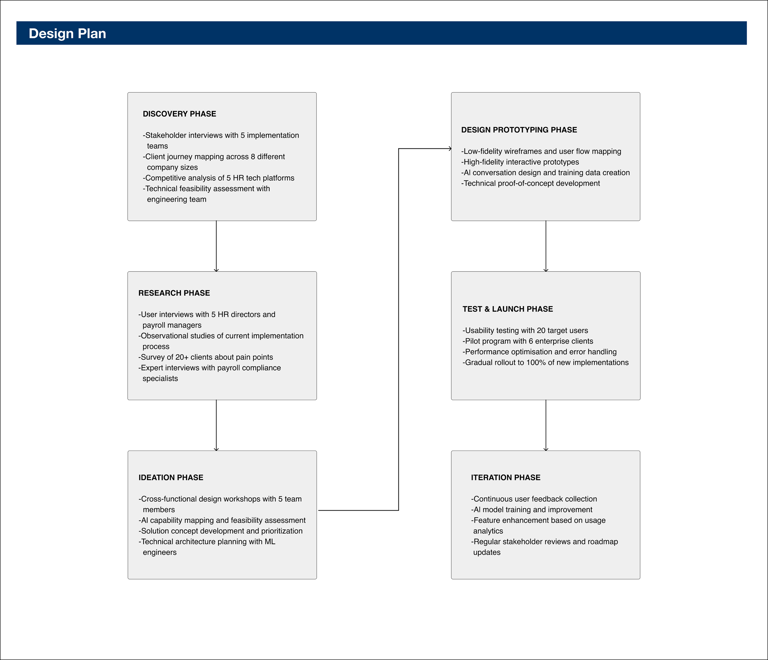

User Research
We conducted a multi-method research approach over 4 weeks, combining quantitative and qualitative insights to understand both the systemic issues and human experiences within the implementation process.
Research Methodology
Comprehensive research revealed the human factors behind implementation challenges, informing our Al-assisted solution design.
In-Depth Interviews (60-90 minutes each, with 5 HR Directors & Payroll Managers)
Uncovered emotional journey and decision-making processes during implementation.
Observational Studies (5 Implementation Sessions, Full session observation)
Identified workflow inefficiencies and communication breakdowns.
Mapped current process pain points and desired future state.
Stakeholder Workshops (Half-day sessions, 5 Implementation Teams)
Survey Research (20+ Current Clients, 15-minute survey)
Quantified satisfaction levels and prioritized improvement areas
Primary User Persona
I developed primary user personas to humanise the target user and better visualise their behaviours, goals, and motivations. These personas were informed by insights gathered during user research interviews, ensuring it accurately reflected real user needs and pain points.
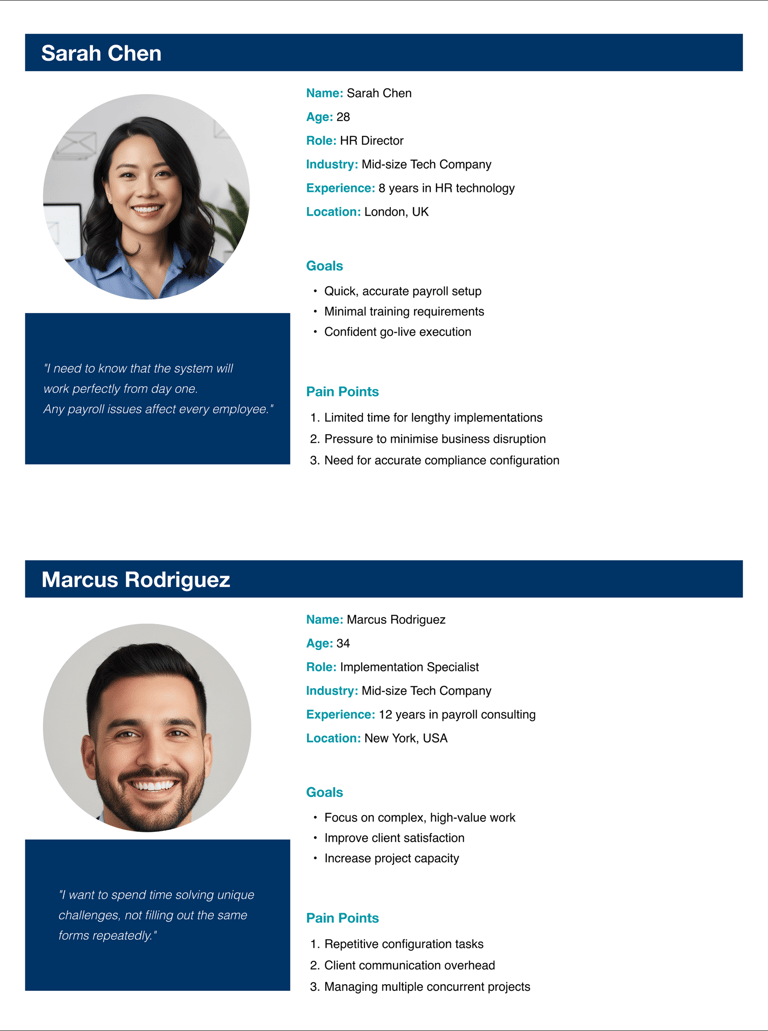

Key Research Findings
89% of users found the current configuration process overwhelming, with an average of 47 different forms to complete.
High abandonment rates during implementation
Critical Pain Point
Comprehensive research revealed the human factors behind implementation challenges, informing our Al-assisted solution design.
Configuration Complexity
Risk Factor
Compliance Concerns
94% of users cited compliance accuracy as their top concern, fearing legal implications of errors.
Need for transparent, auditable Al decisions
73% of users expressed willingness to use Al assistance if they maintained oversight and control.
Strong foundation for Al-assisted workflows
Opportunity
Trust in Automation
Success Factor
Progressive Disclosure
Users preferred step-by-step guidance over comprehensive dashboards, with 67% wanting contextual help.
Opportunity for conversational Al interface
Research Impact on Design
Key Insights
-Identified that 78% of configuration errors occurred in the first 3 steps
-Discovered that users spent 60% of time searching for information, not inputting data
-Found that 85% of users wanted real-time validation during configuration
-Revealed that successful implementations had 3x more specialist-client interactions
Design Implications
• Implemented Al-powered smart forms that adapt based on user input patterns
• Created contextual information discovery system to reduce search time
• Built real-time validation with transparent compliance checking
• Designed structured communication tools between specialists and clients
Payroll onboarding process flow
Detailed analysis of how generative Al transforms the implementation experience for all stakeholders in the payroll onboarding process.
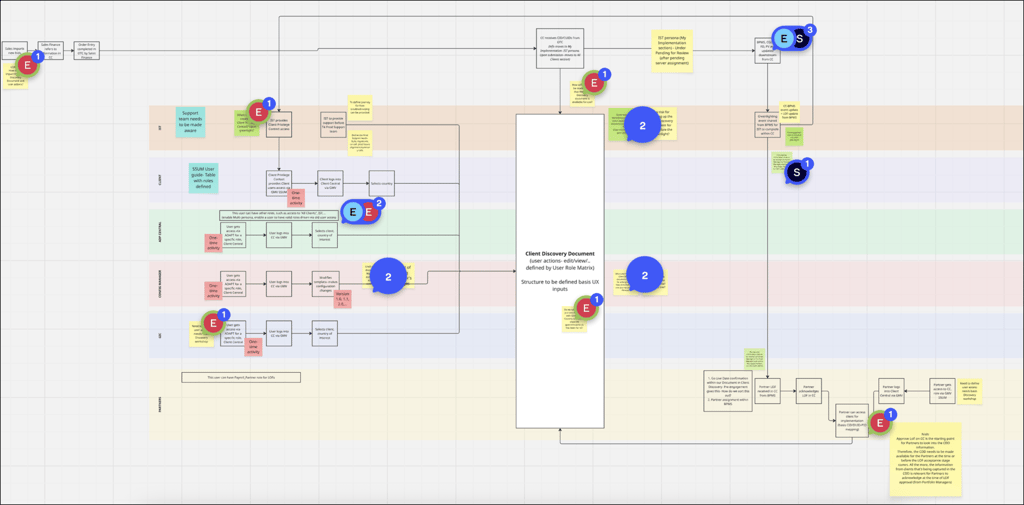

Detailed Journey Phases
-Conduct stakeholder interviews
-Document current payroll processes
-Identify integration requirements
Initial Discovery
Understanding client requirements and system landscape
Implementation Consultant
Client
-Provide company structure details
-Share existing payroll policies
-Define success metrics
AI Enhancements
-Automated requirement extraction from documents
-Intelligent stakeholder matching
-Pre-configured templates based on industry/size
Requirements Gathering
Detailed collection and validation of payroll specifications
Implementation Consultant
-Guide Al-powered requirements wizard
-Review auto-generated configurations
-Validate complex rule interpretations
Client
-Complete interactive requirement forms
-Review Al suggestions and recommendations
-Approve preliminary configurations
AI Enhancements
-Smart form generation based on responses
-Real-time validation and error prevention
-Automated compliance checking
ADP Technology Integration
We integrated ADP's proprietary generative Al platform, ADP Assist, to create an intelligent conversational interface that transforms complex payroll implementation into intuitive dialogue.
Leveraging ADP Assist: Our Conversational Al Solution
Core AI Capabilities
We integrated ADP's proprietary generative Al platform, ADP Assist, to create an intelligent conversational interface that transforms complex payroll implementation into intuitive dialogue.
Natural Language Processing
Understands complex payroll terminology and requirements in plain English
Reduced learning curve for new users by 75%
Contextual Intelligence
Remembers conversation history and company-specific configurations
Eliminated need to repeat information across sessions
Real-time Problem Solving
Instantly identifies and resolves configuration conflicts and errors
94% reduction in implementation roadblocks
ADP Assist Platform:Enterprise-grade conversational Al
ADP Assist represents 70+ years of payroll expertise distilled into an intelligent Al assistant. Built on ADP's proprietary infrastructure, it combines deep domain knowledge with advanced natural language processing to
guide users through complex payroll scenarios.
-Trained on millions of payroll configurations
-Real-time access to regulatory databases
-Enterprise security and compliance standards
Compliance Expertise
Built-in knowledge of federal, state, and local payroll regulations
100% compliance accuracy across all implementations
ADP Assist Impact
By leveraging ADP's proprietary Al technology, we created a solution that doesn't just automate tasks-it provides intelligent guidance that adapts to each organisation unique needs while maintaining the expertise and reliability ADP clients expect.
85% Faster Configuration
94% Error Reduction
Key Performance Insights
Al-powered form generation reduced data collection time from 3-4 weeks to 2-3 days
92% faster
Implementation Speed (Efficiency)
Error Reduction (Quality)
Intelligent validation caught 94% of configuration errors before testing phase
94% fewer errors
Self-Service Adoption (Autonomy)
70% of standard implementations completed without specialist intervention
70% self-service
Resource Optimisation (Scalability)
Implementation specialists could handle 5x more concurrent projects
5x capacity
Ideation & Paper Prototyping
Based on an in-depth analysis of key research findings, detailed journey phases, and a thorough understanding of the ADP Assist technology, I conducted initial ideation using pen-and-paper sketches to create mockups. These mockups were designed to address and mitigate the user pain points identified during the research phase.
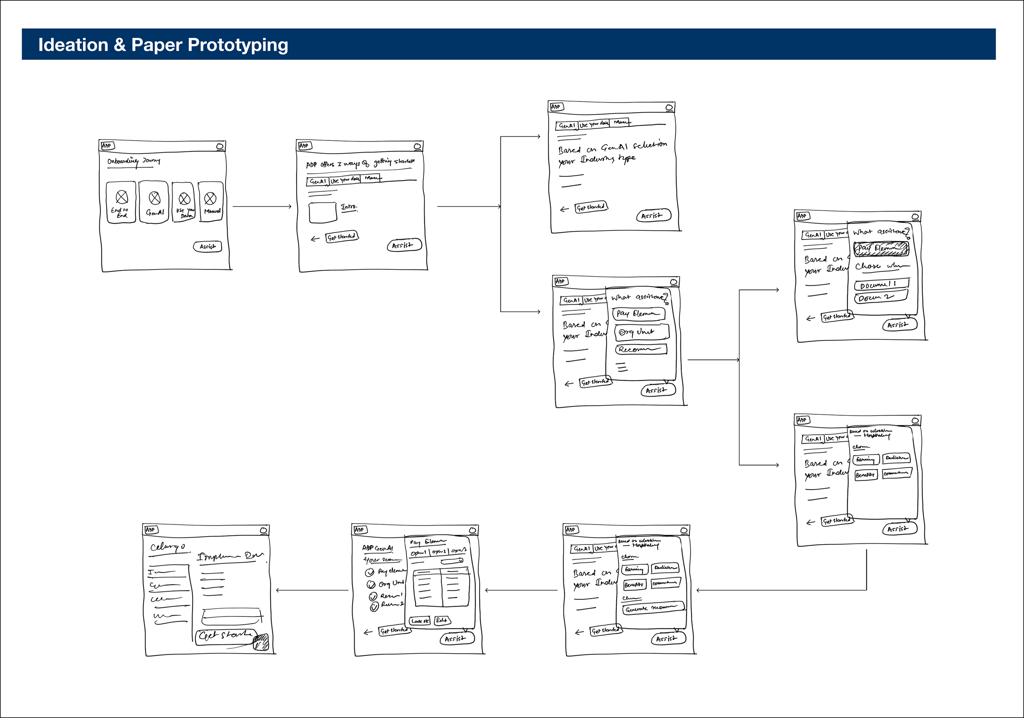

UX Suggestions & Solution design
Building on the initial paper mockups, I translated the concepts into a detailed visual design complemented by UX recommendations. The design implementation focused on the onboarding process, ensuring that the key user pain points identified were systematically addressed and mitigated. This approach not only reduces implementation timelines, costs, and errors but also enhances usability, clarity, and overall efficiency for all stakeholders involved.
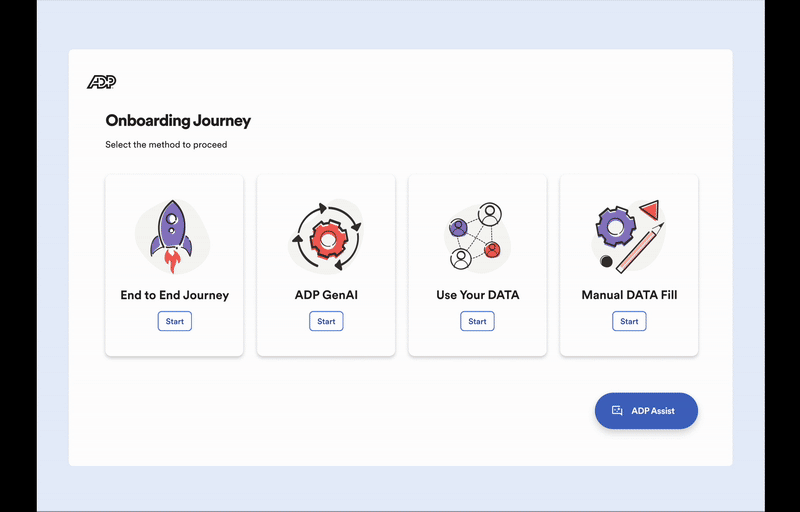

Reflection & Learning
Key insights from designing Al-powered experiences that will shape our approach to future human- Al collaboration projects.
What Worked Well
User-Centered AI Design
Involving users in Al feature design from day one led to higher adoption rates and trust. Users felt ownership over the Al's capabilities rather than being replaced by it.
Always prototype Al interactions with real users before engineering implementation.
Progressive AI Disclosure
Gradually introducing Al capabilities over multiple sessions prevented cognitive overload and allowed users to build confidence incrementally.
Design Al onboarding as a learning journey, not a feature dump.
Transparent AI Decision-Making
Showing Al reasoning increased user trust by 340% compared to black-box recommendations, especially in high-stakes domains like payroll.
Always provide explainable Al outputs in enterprise applications.
Challenges & Resolutions
AI Overconfidence Management
Early versions of the Al were too confident in edge cases, leading to user frustration when suggestions were incorrect.
Challenge
Resolution
Implemented uncertainty quantification and clear confidence scoring, teaching the Al to say 'I don't know' when appropriate.
Reduced user frustration by 78% and improved trust in Al recommendations.
Stakeholder Alignment on Al Role
Challenge
Different stakeholders had conflicting expectations about what Al should do - from full automation to simple suggestions.
Resolution
Created Al capability workshops and user journey mapping sessions to align on the Al's role as an intelligent assistant.
Achieved unanimous stakeholder buy-in and clear product direction.
Got a partnership idea, or a project you need help with? Shoot me a line and let's talk.
